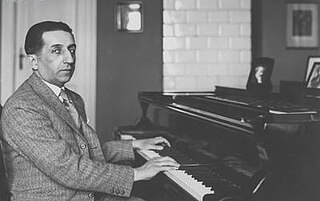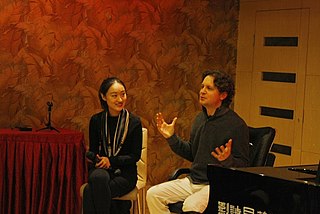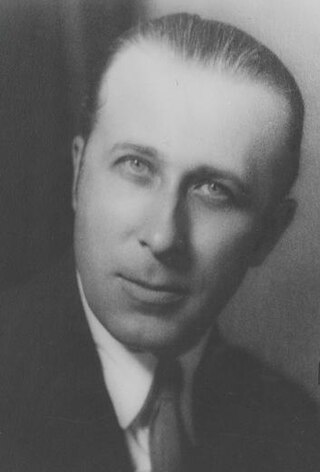
Grażyna Bacewicz Biernacka was a Polish composer and violinist of Lithuanian origin. She is the second Polish female composer to have achieved national and international recognition, the first being Maria Szymanowska in the early 19th century.

Lev Nikolayevich Oborin was a Soviet and Russian pianist, composer and pedagogue. He was the winner of the first International Chopin Piano Competition in 1927.
Serge Yulievitch Conus was a Russian pianist and composer who performed in the United States and Europe.
Tālivaldis Ķeniņš was a Canadian composer. He was forced to emigrate from Latvia when it fell under Soviet occupation after World War II, moving to Canada around 1951. He is credited by Canadian musicologist Paul Rapoport with having introduced many European idioms to Canadian art music. CBC Music described him as a "pioneering Canadian composer" and The Canadian Encyclopedia described him as "one of Canada's most frequently commissioned composers."

Zbigniew Drzewiecki was a Polish pianist who was for most of his life a teacher of pianists. He was especially associated with the interpretation of Frédéric Chopin's works. His pupils include several famous pianists of the 20th century, and his influence was therefore very pervasive.

Daniel Vnukowski is a Polish Canadian pianist and classical music broadcaster.
Joel Spiegelman was an American composer, conductor, concert pianist, harpsichordist, recording artist, arranger, author and professor.

Frank Squire Welsman was a Canadian conductor, pianist, composer and music educator. He began his career as a concert pianist, but ultimately earned his place in Canadian history for establishing Toronto's first symphony orchestra of any standing, the Toronto Symphony Orchestra which was active from 1906 to 1918. As a composer he wrote a few songs and some instrumental pieces, mostly works for solo piano. His grandson John Welsman is a notable film score composer and his granddaughter Carol Welsman is a successful jazz pianist and singer.
Neil Chotem was a Canadian composer, arranger, conductor, pianist, and music educator.
Norma Marian Beecroft is a Canadian composer, producer, broadcaster, and arts administrator. A member of the Canadian League of Composers and an associate of the Canadian Music Centre, she twice won the Canada Council's Lynch-Staunton Award for composition. She has been commissioned to write works for such organizations as the Atlantic Symphony Orchestra, the Canadian Broadcasting Corporation, the Canadian Electronic Ensemble, The Music Gallery, the National Arts Centre Orchestra, the National Ballet of Canada, the Quebec Contemporary Music Society, the Toronto Symphony Orchestra, and York Winds among others. She is an honorary member of the Canadian Electroacoustic Community and has served on the juries of the SOCAN Awards and the Jules Léger Prize for New Chamber Music. In 1988 she donated many of her original manuscripts, papers, and recordings to the library at the University of Calgary.
Joseph Rodolphe Mathieu was a Canadian composer, pianist, writer on music, and music educator. The Canadian Encyclopedia states, "Considered too avant-garde for his time because of Debussy's influence on his music, Mathieu gained recognition too late to inspire the generation that followed." The pianist Léo-Pol Morin was one of the few important exponents of his work, notably including Mathieu's Chevauchée and Trois Préludes in his concert repertoire. Mathieu's song Un peu d'ombre (1913) was included in a number of recitals given by Marguerite Bériza and Sarah Fischer in Europe.

Pierre Brabant was a Canadian composer and pianist. He appeared in concerts and recitals throughout Canada and performed numerous times on Canadian television and radio. He wrote music for a number of programs for the Canadian Broadcasting Corporation and worked as a composer, arranger, and music director for numerous recordings by a variety of Canadian artists. Starting in 1987 he performed regularly in concerts and recitals as the accompanist for opera singer Joseph Rouleau.
Albert Pratz was a Canadian violinist, conductor, composer, and music educator. He was awarded the Canadian Centennial Medal in 1967. His compositional output was modest and consists of only instrumental works. Some of his compositions, such as Melanie Waltz (1956) and A Tango (1957), were recorded by the CBC Symphony Orchestra; of which he was concertmaster from 1953 to 1961. He worked in the same capacity for the Buffalo Philharmonic Orchestra from 1966 to 1969, and the Toronto Symphony Orchestra from 1970 to 1979. He was also active as a teacher, both privately and at a number of universities, and made recordings as both a violinist and conductor.

Jean-Marie Beaudet was a Canadian conductor, organist, pianist, radio producer, and music educator. He had a long career with the Canadian Broadcasting Corporation, serving variously as a music producer, programing director, conductor, and administrator. With the CBC Symphony Orchestra he conducted the premiere recordings of works by many Canadian composers, including pieces by Maurice Blackburn, Claude Champagne, J.-J. Gagnier, Clermont Pépin, and Healey Willan.
Jocelyne Binet was a Canadian composer, pianist, and music educator. She studied in Montreal and Paris, France, and returned to compose and teach music in Canada.

Georg Liebling was a German pianist and composer. Part of the Liebling family of musicians, he had an active international career as a concert pianist and accompanist from the 1880s into the 1920s. He also worked as a piano teacher for most of his life, beginning that occupation at the age of 16 and continuing up until his death more than 50 years later. He taught on the faculties of the Kullack Conservatory in Berlin (1881–1889), the Guildhall School of Music in London (1898–1906), and the Hollywood Conservatory of Music in the early 1930s in addition to teaching privately in Berlin, Munich, and New York City. As a composer, his salon compositions are noteworthy, especially the Air de Ballet and Romance; a gavotte, and the vocal Lieblingswalzer. Also notable is his 1908 opera Die heilige Katharina.
The Faculty of Music at the University of Toronto is one of several professional faculties at the University of Toronto. The Faculty of Music is located at the Edward Johnson Building, just south of the Royal Ontario Museum and north of Queen's Park, west of Museum Subway Station. MacMillan Theatre and Walter Hall are located in the Edward Johnson Building. The Faculty of Music South building contains rehearsal rooms and offices, and the Upper Jazz Studio performance space is located at 90 Wellesley Street West. In January 2021, the Faculty announced Dr. Ellie Hisama as the new Dean starting July 1, 2021.
After its arrival in Cuba at the end of the 18th century, the pianoforte rapidly became one of the favorite instruments among the Cuban population. Along with the humble guitar, the piano accompanied the popular Cuban guarachas and contradanzas at salons and ballrooms in Havana and all over the country.

Minuetta Shumiatcher Borek Kessler was a Russian-born Canadian and later American concert pianist, classical music composer, and educator. A child prodigy, she performed her first composition at a recital at the age of 5 in Calgary, Alberta, Canada, and went on to study at the Juilliard School in New York City. She composed hundreds of pieces, including music for piano, violin, voice, flute, clarinet and cello, as well as for chamber ensembles. She performed all over Canada and in Boston and New York, including performances at Carnegie Hall and The Town Hall, and with the Boston Civic Symphony and the Boston Pops. The New York Times called her "a rare phenomenon among the younger pianists of today – more musician than pianist". She also taught musical composition to young children, creating and patenting a game called "Staftonia" for this purpose.

Wiktor Łabuński, was a Polish-American pianist, conductor and composer. He came to the United States in 1928, where he made his debut as a pianist at Carnegie Hall.









